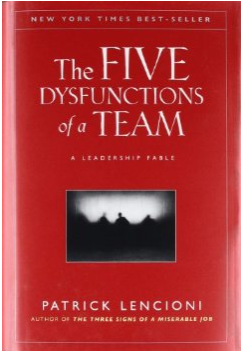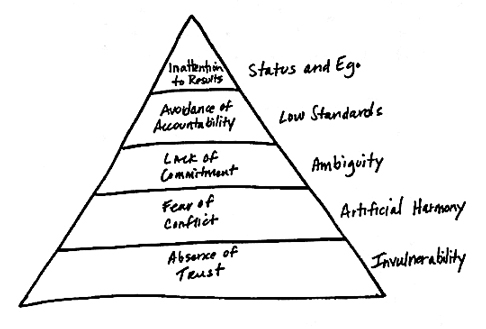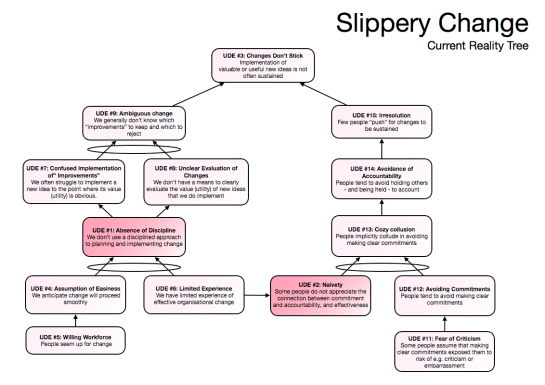Sticky Change
Sticky Change
Just about everyone involved in team-building must by now have heard of – if not actually read – Patrick Lencioni’s book “Five Dysfunctions of a Team“.
In this book he describes the “five dysfunctions” that any team faces – and has to overcome – on the path to truly effective teamwork. (What DeMarco and Lister call “jelled teams“).
The Roots of Ineffective Change
When working with relatively ineffective organisations looking to Rightshift, I generally see sincere, committed and engaged folks trying out new ideas and new ways of working. (Note: I try to avoid working with organisations where folks are insincere, lacking in commitment, and disengaged). But all too often I see such attempts at innovation abandoned long before they have been mastered, and even before they have been applied enough to assess their merits (i.e. their value, or utility). In other words, most changes just do not stick. Why does this happen?
I attribute it to at least two reasons.
Change is Simple, Isn’t It?
The first is a general belief that introducing new ideas into the organisation is going to be relatively simple and straightforward. With a willing workforce, with relatively little (perceived) resistance to change, why would introducing new ideas be difficult? This is particularly true of organisations with Ad-hoc or Novice Analytic mindsets (see: The Marshall Model white paper).
Why Bother Making Commitments?
The second reason, and somewhat a consequence of the first, is when folks fail to commit – formally and publicly – to what they will do. (See also: the GROW model from Sir John Whitmore, Coaching for Performance).
Note: There are lots of models, methods, workshop exercises, etc. to help teams build mutual trust, the ability to have positive and productive conflict, the ability to make commitments, to raise standards of mutual accountability, and to downplay status and ego. Some I have used to good effect in the past include:
- Social Styles (Wilson Learning). My first choice for teams who want to get to know one another better in the context of collaboration at work.
- StrengthsFinder (Gallup). Very useful to help individuals better understand their own talents (strengths). Share the results to build mutual understanding.
- The Keirsey Temperament Sorter. (A kind of MBTI assessment). Ditto.
- Meyers-Briggs Type Indicator (MBTI). Ditto.
- The Belbin Team Inventory. Ditto, plus highlights potential “gaps” in team makeup.
- Various Exercises from e.g. “The Fifth Discipline Fieldbook” and “Overcoming the Five Dysfunctions of a Team” (c.f. Further Reading section, below).
- Purposeful Dialogue (c.f. David Bohm, Chris Argyris).
- Mutual Learning (e.g. Argyris and Schon, Roger Schwarz & Associates, Nancy Kline)
- Team Coaching exercises from Coaching for Performance
- Joint Exploration of issues using e.g. Mind Maps, Value Maps, Value Stream Maps, Current Reality Trees, Evaporating Clouds, and other Theory of Constraints, etc. tools.
For those who relate better to visual forms of information, I have drawn up a Current Reality Tree (CRT) to better illustrate this scenario:
Fellowship – Mutually Accountable
If you have read or watched The Lord of the Rings, you might note that members of the Nine regularly make commitments to one another, but rarely need to call each other on those commitments (with the possible exceptions of Peregrine Took and Boromir of Gondor). In other words, mutual accountability happens more-or-less naturally, and with little occasion for challenge or conflict. This aspect of fellowship contributes to my belief that fellowship is a beneficial model for collaboration throughout an organisation (and between collaborating organisations, too).
Summary
Why would anyone think that effective organisational change (improvement) was:
- Any less difficult than e.g. developing quality software products?
- Any less valuable, commercially, than the ability to develop quality software reliably and predictably?
- Any less worthy of a considered, deliberate, disciplined and intentional approach of its own?
- Any less worthy of investment and commitment of e.g. dedicated (full-time) people to make it happen (c.f. Scrum teams)?
Maybe for the reasons listed in this post?
– Bob
Further Reading
The Fifth Discipline Fieldbook ~ Peter M. Senge et al
Overcoming the Five Dysfunctions of a Team ~ Patrick Lencioni
First Break All the Rules ~ Marcus Buckingham and Curt Coffman
Solving Tough Problems ~ Adam Kahane
Staying Lean: Thriving Not Just Surviving ~ Cardiff University (long PDF)
The Four Obsessions of an Extraordinary Executive ~ Patrick Lencioni




Example behavior is crucial in change, it shows that you are really committed! What you do says more then what you say.
Thanks Bob for helping us to remember this 🙂
Good point, Ben… Every parent knows that:-)
Thanks for the inspirational post, Bob.